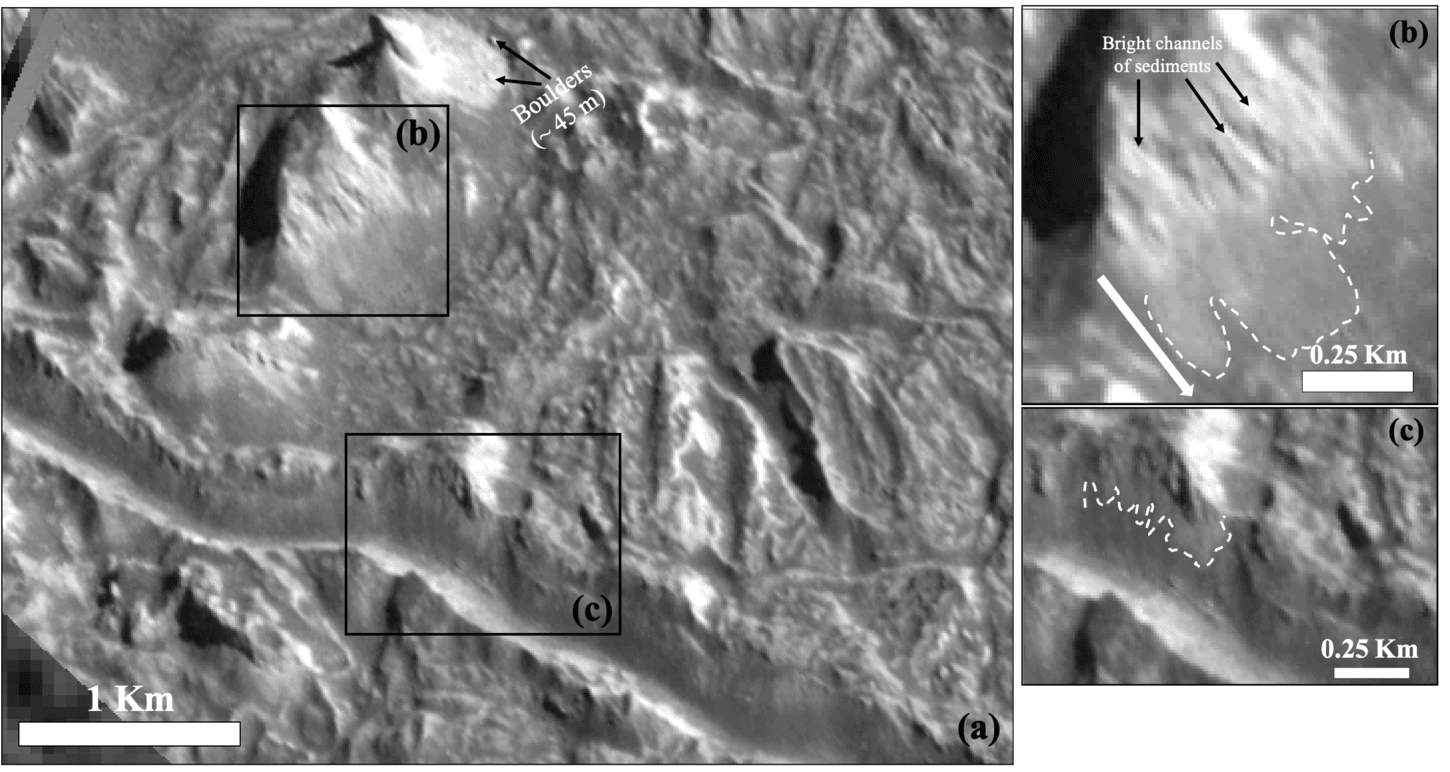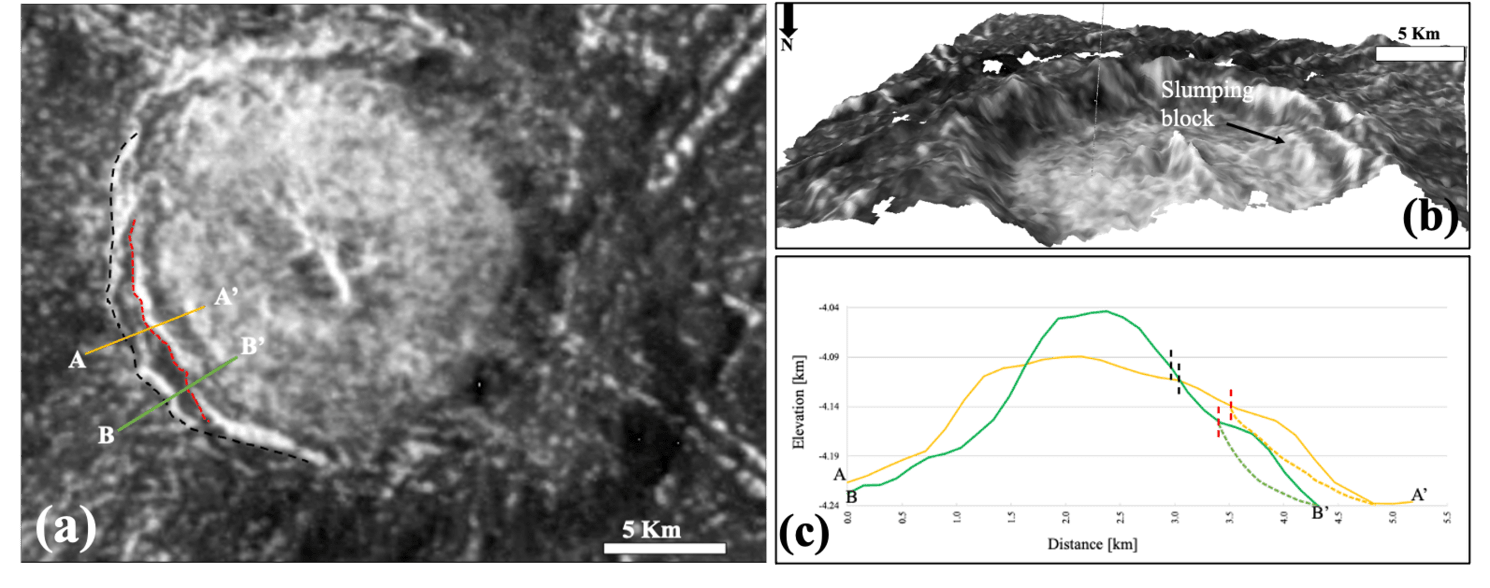- 1Jet Propulsion Laboratory, California Institute of Technology (rutu.a.parekh@jpl.nasa.gov)
- 2Lunar & Planetary Institute / USRA
Introduction: In the post-Galileo era, a few studies have noted the presence of a fragmental debris layer, indicating dry granular-like mass movement and the potential for a thin dusty regolith within the plates of Conamara Chaos on Europa [1,2]. However, these studies have not delved into a comprehensive feature analysis of the mass wasting process. Our research, therefore, takes a novel approach by conducting a detailed morphology and geometrical analysis of two types of mass wasting processes, aiming to fill this gap in knowledge.
Slide: Within Conamara Chaos, we observed multiple semi-independent fan–like wide deposits at the sloping edges of plates, small cones, and ridges (Figure 1a). In general, bright channels of sediments are abundant at the upper walls of the plates (Figure 1b). Figure 1b also highlights (black arrows) a set of narrow sediment channels carved from the bedrock, suggesting closely spaced zones of weakness, such as faults and fractures. The eroded materials are transported via channels, progressing downwards to produce wide fans or debris aprons (Figure 1b, c; white dashed lines). The sediments producing channels and, further downslope, fan-like deposits are usually brighter than the surroundings, indicative of their recent formation (Figure 1b). The fan-like deposits are loosely packed sediments that coat existing surfaces. Additionally, partially buried rock fragments are observed within the deposit margins (Figure 1a), possibly sourced from exposed bedrock from the top. Telescopic observations of Europa noticed that the top few millimeters of regolith have a low thermal inertial, commonly observed in fine-grained materials [3, 4]. Additionally, Galileo images of Europa’s surface showed the presence of loose blocks, clasts, and ice impurities at a local scale [5, 6], suggesting a heterogeneous distribution of regolith mixed with ice [1].
Slump: Within Cilix crater (dia.: ~11 km) on Europa, some degree of erosion is observed in the SW region of the crater. The crater rim has been degraded in various areas, but the SW region is particularly different due to a large chunk that appears to be a slump block (Figure 2a, b, c). The slump block is suspected to be detached from the rim, while the rest of the crater rim is preserved. The slump block is around ~54-77 km2 in area. Topographic profiles show a single-step-like morphology, with an overall elevation difference of ~100m between the crater floor and the head of the deposit (Figure 2b). The ejecta distribution within the eastern side of the crater suggests a thick deposit overlaid on the pre-existing ridge system (Figure 2a). Based on the crater depth and diameter model [9, 10, 12], it was predicted that post-impact, the transient depth of Cilix was between 2.4-4.7km, suggesting the possible existence of brittle weaker material at the top of the solid icy crust [9]. With closer analysis, we noticed that the slope of crater walls in the neighboring region of a slump is steeper (~20-27°) than those present on the NE side (~15°) of the crater. Moreover, minor topographic relief surrounding the ridge (passes from NW to SE direction of the crater) indicates viscous relaxation of the crater floor under the load of the ridge [13] or a beginning of ridge collapse post-crater formation [14]. The steeper slopes of south-to-north regions (except those showing wall slumping) could be due to an oblique impactor from the SWW direction [14]. This also explains the elevation differences between crater rim height (~1000m in NE and ~600m in SW) and slope asymmetry. Hence, the slump is observed within the NEE part of the crater wall [14] and not in the opposite direction where the slope is not steep enough.
Summary: Our study has mapped granular slides with deposits within Conamara Chaos on Europa. These findings, along with the preserved morphology of bright albedo, steep slopes with exposed bedrock at the high elevation, deposit distribution at the lower slope, and the presence of partially buried small boulders with downslope streaks, suggest ongoing surface degradation activity. The location of the slump block, asymmetry in crater slopes, and the geology of the neighboring region further support the hypothesis that slumping might be triggered by the oblique impactor smashing into a weaker, brittle layer at a local scale.
References: [1] Moore et al., 1999, [2] Sullivan et al., 1999, [3] Hansen, 1973 [4] Molaro et al., 2018, [5] Moore et al., 2009, [6] Daubar et al., 2024, [7] Domingue and Verbiscer 1997, [8] Hendrix et al. 2005, [9] Moore (2001), [10] McKinnon & Schenk, 1991,[11] McKinnon & Schenk, 1995, [12] Moore et al., 2001, [13] Greeley et al., 1982, [14] Giese et al., 1999.
Acknowledgements:
The Europa Clipper Project supported this work. The research described in this manuscript was conducted at the Jet Propulsion Laboratory, California Institute of Technology, under a contract with the National Aeronautics and Space Administration. Our team would like to acknowledge the work of the Galileo instrumental teams and the PDS imaging node for making this data publicly available.

Figure 1 (a) Example of fan-like slide deposits observed within the Conamara Chaos region. (b) The material travels downwards with multiple fronts producing wide fan-like deposits. A distinct example of bright channels of sediments (black arrows) with poorly developed deposit fan (white dashed lines). The white arrow indicates the direction of slide deposits. (c) White dashed lines trace the fan deposits formed at the intermediate part of the slopes within the large ridge that may have exploited the fractured bedrock at the top. Image resolution:11m/pixel, image id:12ESCHAOS_01.

Figure 2 (a) Cilix crater with slump block on the SE region. Note that the rim of this crater is substantially degraded, especially in the NE area, where it is difficult to see part of the rim (north up). (b) 3D visual representation of part of Cilix impact crater where detached slump mass is seen. (c) A step-like slumping block with a topographic profile is shown as A-A’ (orange line) and B-B’ (green line). Black and red dashed lines correspond to the rim head and scarp crown. Lat.: 2.6°N, long.:177.5°E. Image res.: 62 m/pixel; id: 15ESCILIXS02
How to cite: Parekh, R., Scully, J., Pappalardo, R., Cameron, M., and Schenk, P.: An overview of small-scale mass wasting surface degradation process on Europa, Europlanet Science Congress 2024, Berlin, Germany, 8–13 Sep 2024, EPSC2024-647, https://doi.org/10.5194/epsc2024-647, 2024.